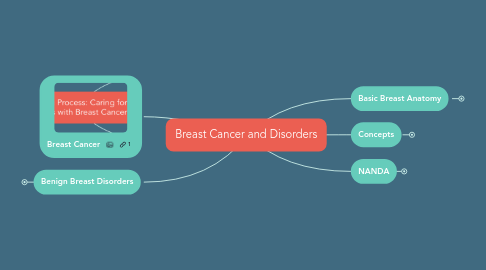
1. Breast Cancer
2. Benign Breast Disorders
2.1. Fibroadenoma
2.1.1. Young
2.1.1.1. Age 20's to 30's
2.1.2. S/S
2.1.2.1. Smooth, rubbery, mobile mass
2.2. Fibrocystic Changes
2.2.1. Age 30's to 50's
2.2.2. Etiology
2.2.2.1. Imbalance in estrogen-to-progesterone ratio
2.2.2.1.1. Response to monthly hormonal changes
2.2.3. S/S
2.2.3.1. Breast pain and tender lumps
2.2.3.1.1. Fluctuate with menstrual cycles
2.2.3.2. Palpable lump
2.2.3.2.1. Round, well delineated, freely movable
2.2.3.3. Nipple discharge
2.2.3.3.1. Milky, yellow, green
2.3. Ductal Ectasia
2.3.1. Age > 50's
2.3.2. Blockage of breast ducts
2.3.3. S/S
2.3.3.1. Nipple discharge
2.3.3.1.1. Thick and sticky
2.3.3.1.2. Greenish or black
2.3.3.1.3. Inverted or tender nipple
2.4. Intraductal Papilloma
2.4.1. S/S
2.4.1.1. Nipple discharge
2.4.1.1.1. Clear or bloody
2.4.1.2. Lump
2.4.1.2.1. Behind or next to the nipple
2.4.1.2.2. Maybe painful
2.5. Mastitis & Breast Abscess
2.5.1. Age 15 to 45 Years
2.5.1.1. Lactating age
2.5.2. Etiologies
2.5.2.1. Breast infection
2.5.2.1.1. Poor breastfeeding or lactation
2.5.2.1.2. Nipple injury
2.5.2.1.3. Skin infection
2.5.2.2. Most common bacteria
2.5.2.2.1. Staph aureus
2.5.3. S/S
2.5.3.1. Breast pain, warmth, tenderness, erythema
2.5.3.2. Flu-like symptoms, fever, malaise
2.5.4. Antibiotic treatment
2.6. Male Gynecomastia
2.6.1. Etiologies
2.6.1.1. Anabolic steroid
2.6.1.2. Antiandrogen therapy
2.6.1.2.1. e.g., prostate cancer
2.6.1.3. Sex reassignment surgery
2.6.1.3.1. Male-to-female
2.6.2. S/S
2.6.2.1. Bilateral breasts
2.6.2.2. Increase breast tissue
2.6.2.3. Erectile dysfunction or decreased libido
3. Basic Breast Anatomy
3.1. Breast anatomy and disease locations
3.1.1. Breast anatomy & surrounding tissues/vessels
3.1.1.1. Lymphatic drainage of the breast
4. Concepts
4.1. Cellular regulation
4.1.1. Breast cancer
4.1.2. Benign breast tumor
4.2. Pain
4.2.1. Mastalgia
4.2.1.1. Breast Cancers
4.2.1.1.1. Most breast CA are painless
4.2.1.1.2. Inflammatory breast CA
4.2.1.2. Benign breast disorders
4.2.1.2.1. Fibrocystic breast condition
4.2.1.2.2. Mastitis or breast abscess
4.2.2. Post-op breast surgeries
4.2.2.1. Incisional pain
4.2.2.2. Neuropathic pain
4.2.2.2.1. Nerves involved (inside of armpit to elbow)
4.2.2.2.2. Mostly resolved within one year
4.3. Infection & Inflammation
4.3.1. Mastitis or breast abscess
4.3.2. Post-op breast surgeries
4.4. Sexuality & Body Image
4.4.1. Physical or psychosocial
4.4.1.1. Post-breast surgeries
4.4.1.1.1. Loss of breast
4.4.1.2. Disease process or treatment
4.4.1.2.1. Lack of libido
4.4.1.2.2. Male gynecomastia
4.4.1.3. Patients may be embarrassed to discuss sexual dysfunction
